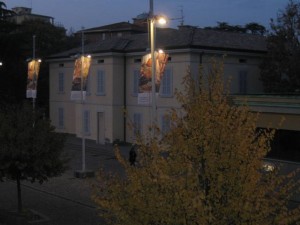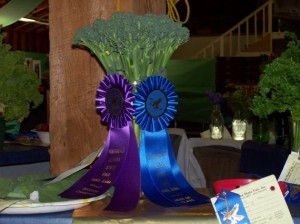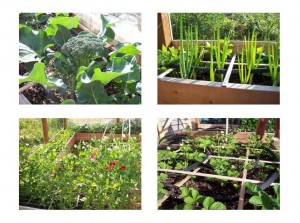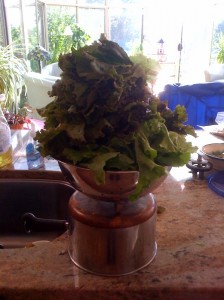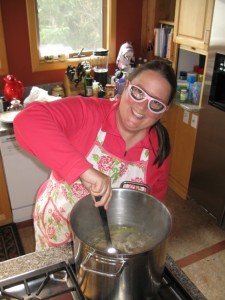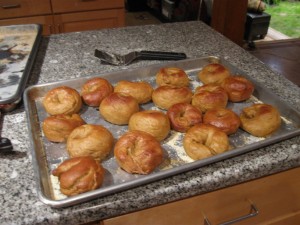Michelle LaBrosse, PMP
As part of my effort to teach project management through cooking, I’m posting my healthy cocktail recipes.
Project Initiation – for some unknown reason after my 44th birthday I became unable to drink alcohol without getting very violent stomach upsets (I now think this was a wonderful gift). But I am also known as the Chief Party Officer for my company. So, over the past several years, I have worked on making non-alcoholic adult beverages. The amazing thing about these drinks, they are also good for you.
Here is the research my trusty intern Erica dug up on how the ingredients in these drinks help you stay healthy:
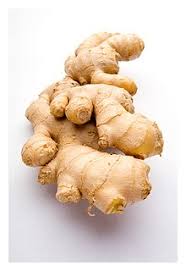
Ginger Root - Available in Most Grocery Store Produce Sections
Ginger – History and medical benefits from: http://www.fitnessandfreebies.com/fitness/ginger.html and http://www.umm.edu/altmed/articles/ginger-000246.htm
Asian, Indian, and Arabic people have been using ginger for its medicinal properties since ancient times. China has been using ginger for over 2,000 years to remedy various ailments including stomach upset and nausea. Pythagorus was an avid user of ginger in Ancient Greece. King Henry VIII of England used ginger to protect himself from the plague. In the past, ginger has also been used for treating arthritis, colic, heart conditions, colds, flu symptoms, menstrual cramps, and headaches.
Although historically, there have been a multitude of uses of ginger, present day research has confirmed that ginger is beneficial in remedying several common ailments. For example, the American Pyschotherapy Research Laboratory in Salt Lake City and Japanese researchers found that motion sickness can be curbed by consuming ginger. Researchers in Denmark have discovered that ginger blocks substances that cause blood vessel inflammation in the brain which leads to migraines. Ginger is so effective that medical professionals often recommend the consumption of it to prevent or treat nausea or vomiting that occurs as a result of motion sickness, pregnancy, and cancer chemotherapy, digestion problems, common colds and flu-like symptoms, and inflammation.

Just Blueberry Juice
Blueberries – History and medical uses of blueberries found on http://www.blueberry.org/health.htm, http://www.health-products-for-women.com/benefits-of-blueberry-juice.html, and http://business.intuit.com/article/history-and-facts-on-blueberries
Blueberries have long been gathered and used by native Americans. They used parts of the plant for medicine, the leaves for tea, and the blueberry juice to relieve coughing. Blueberries and blueberry juice have been proven to have powerful medical benefits when ingested. Blueberries have one of the highest levels of antioxidants of all fruits and vegetables. Antioxidants help neutralize free radicals that our bodies produce as part of our aging process. Consuming antioxidant-rich foods helps curb age-related problems including short term memory loss and coordination. Blueberry juice not only protects against negative side effects of aging, it has also been shown to reduce bad cholesterol in the blood which contributes to heart disease and strokes, decrease urinary tract infections, act as an anti-inflammatory, stimulate the immune system.
Cranberries – Cranberry and cranberry juice history and medical uses from: http://www.umm.edu/altmed/articles/cranberry-000235.htm and http://www.associatedcontent.com/article/34119/the_health_benefits_of_cranberry_juice.html
Cranberries, like blueberries, have been used as both a food and a medicine for many years. Native Americans have used cranberries to treat bladder and kidney diseases. England settlers used the cranberries in America when they arrived to aid in appetite loss, scurvy, and digestive problems. The most common medicinal use of cranberries is for preventing urinary tract infections. Cranberries prevent bacteria from attaching urinary tract walls. Medical professionals recommend ingesting cranberries (in supplemental form or juice) to help prevent but not cure urinary tract infections. Even though this is the most common and often referred to use of cranberries, there are several other medical purposes for this berry. Not only do cranberries (and cranberry juice) contain many vitamins and minerals, but it is a source of antioxidants that fight aginst heart disease and caner. Cranberry juice can also help prevent ulcers from forming by preventing bacteria that causes ulcers from attaching to stomach walls. Cranberries are high in vitamin C and contains other components that help prevent gum disease and plaque buildup.
Green Tea – Green tea history and health benefits from: http://www.umm.edu/altmed/articles/green-tea-000255.htm and http://chinesefood.about.com/library/weekly/aa011400a.htm
People have been consuming green tea for at least 500,000 years and many cultures have been using it for a variety of purposes. The Chinese are one such people that have been consuming and using green tea for its many medicinal benefits. Research has demonstrated that ancient Chinese cultures used green tea to treat many ailments from headaches to depression. Chinese and Indian cultures both used green tea as a diuretic, an astringent, a stimulant, and to maintain a healthy heart. Today, research has been conducted to uncover what exact medical benefits arise from consuming green tea. Out of the three main varieties of tea (black, oolong, and green), green tea has the highest concentration of free radical fighting anti-oxidants. Recent studies on green tea have concluded that drinking it can reduce the risk bladder, esophageal, breast, ovarian, lung, skin and several other cancers. Green tea also reduces total cholesterol and improves the ratio of good to bad cholesterol found in our bodies. Consumption of green tea has also been found to control the body’s blood sugar levels, prevent liver disease, prevent tooth decay, and boost the body’s metabolism. The many health benefits associated with green tea are due what the plant is made of including polyphenols (powerful antioxidants) and stimulating alkaloids like caffeine.
Grapefruit Juice – The grapefruit’s history is relatively more recent than that of other fruits. The grapefruit was discovered just in the 18th century in Barbados and botanists think that the grapefruit may be the result of a natural cross breeding between the orange and a citrus fruit called the pomelo. The grapefruit has many health benefits that are similar to those of an orange including their high levels of vitami C and antioxidant properties. Grapefruits contain a carotenoid phytonutrient called lyopene, which has anti-tumor properties. Lycopene is highly efficient in fighting oxygen free radicals that may cause cell damage. Grapefruit juice is one of the most antioxidant rich juices available. Grapefruit juice also contains phytonutrients called limonoids that prevent tumors from forming. Other research done on this delicious fruit have show that it can lower cholesterol, prevent kidney stones, protect against colon cancer, and can help the the productivity of liver detoxification. Grapefruit juice has many valuable health benefits but it is recommended that you discuss the addition of this fruit to your diet if you take medications because it could interfere with the breakdown or distribution of your medication. To learn more about this fruit go to http://www.whfoods.com/genpage.php?tname=foodspice&dbid=25 or http://www.associatedcontent.com/article/592239/natural_health_benefits_and_uses_of.html?cat=5
Orange Juice – Oranges are one of the most popular fruits around the world and orange juice is also widely used because of its delectable taste and its numerous health benefits. Most commonly, we have heard that orange juice contains large amounts of vitamin C. This is true–one orange provides you with over 100% of your daily vitamin C need. Vitamin C is an antioxidant and can protect the body against free radicals that cause cellular damage like cancer. One study by Italian researchers at the Division of Human Nutrition at the University of Milan found that drinking a glass of orange juice is more protective than consuming vitamin C by itself. In combination with other components of an orange, vitamin C aids in preventing illnesses caused by free radicals including heart disease and cancer. Orange juice’s many benefits also include protection against cardiovascular disease, lowering of cholesterol, being a great source of fiber, preventing kidney stones, preventing ulcers, and protecting respiratory health.
To read more about the health benefits of orange juice go to http://www.whfoods.com/genpage.php?tname=foodspice&dbid=37 or http://www.americanchronicle.com/articles/view/54063
Pomegranate Juice – Pomegranates have been eaten for quite some time and have only recently become very popular in the United States because of their health benefits. The pomegranate is one of the earliest cultivated fruits and records have traced the consumption of it back to at least 3,000 B.C. Scholars have even speculated that Eve in the Bible was tempted by a pomegranate rather than an apple. In many cultures, the pomegranate is associated with fertility and rebirth. Prominent Egyptians such as King Tut were even buried with the fruit because they hoped it would help them travel to their second life. Until recently, pomegranates have been a constant mainly in diets of the Middle Eastern people. When studies came out regarding the health benefits of the fruit, its popularity spread to the U.S. The fruit is full of antioxidants and studies have shown that pomegranate juice aids in destroying breast cancer cells, preventing lung cancer, preventing osteoarthritis, protects arteries, lowers bad cholesterol while raising good cholesterol, prevents dental plaque, and protects the arteries from plaque buildup. One study even found that drinking 1.7 ounces of pomegranate juice a day can lower systolic blood pressure by 5 percent. To learn more aboutthe rich history and many benefits of pomegranate juice, go to http://www.npr.org/templates/story/story.php?storyId=6411097 and http://www.healthdiaries.com/eatthis/11-health-benefits-of-pomegranate-juice.html
 Agave Nectar – Agave nectar is a wise choice for a sweetener because it is low on the glycemic index and therefore will not cause sharp rises or falls in blood sugar. Agave nectar has anti-inflammatory and immune-boosting properties. The Aztecs even used agave syrup as an antibacterial to help heal wounds. Agave nectar has also been found to protect against harmful intestinal bacteria. Agave nectar is a sweet alternative to high-glycemic sugars. It is also thinner than honey, pours and dissolves well in both hot and cold liquids. You can find it in the cooking section or near the honey in most grocery stores. To learn more about agave nectar go to http://www.allaboutagave.com/health-benefits-of-agave-nectar.php and http://www.sheknows.com/articles/804491.htm.
Agave Nectar – Agave nectar is a wise choice for a sweetener because it is low on the glycemic index and therefore will not cause sharp rises or falls in blood sugar. Agave nectar has anti-inflammatory and immune-boosting properties. The Aztecs even used agave syrup as an antibacterial to help heal wounds. Agave nectar has also been found to protect against harmful intestinal bacteria. Agave nectar is a sweet alternative to high-glycemic sugars. It is also thinner than honey, pours and dissolves well in both hot and cold liquids. You can find it in the cooking section or near the honey in most grocery stores. To learn more about agave nectar go to http://www.allaboutagave.com/health-benefits-of-agave-nectar.php and http://www.sheknows.com/articles/804491.htm.
Project Plan
Get ingredients
Seltzer water – 2 half gallons or 4 quarts
Blueberry Juice – 1 quart – no sugar added (or artificial sweetners).
Grapefruit Juice – 1/2 gallon – no sugar added
Cranberry Juice – 1/2 gallon – no sugar added
Pomegranate Juice – 1 pint – no sugar added
Ginger Root – 1 large root
Tazo Zen Green Tea Bags
5 oranges
2 Limes
Organic Cinnamon
Agave Nectar
Ice cubes – 1/2 bag or 4 cups
Equipment
16 oz drink glasses
Project Execution
Blueberry Pie Drink
I got the idea for this drink from a Tazo Brambleberry drink – but then the little store in the little town where I live wasn’t carrying it anymore so I tried to make something similar on my own. Not to be a braggart or anything, but mine is better.
Directions
Fill the glass with ice
Sprinkle cinnamon on ice
Shake to coat ice with cinnamon
Fill the glass 7/8th full with seltzer water
Fill remaining glass with blueberry juice
Enjoy
Pink Flamingo Drink
This is a drink I order when I’m out at restaurants and bars with others. I have found that when everyone is enjoying a cocktail, they just feel more comfortable if they feel like you are enjoying a drink too. This drink is very refreshing and I often find people switching to it after they try it.
Directions
Fill the glass with ice
Squeeze a wedge of lime on the ice and shake to coat
Fill with 3/4 seltzer water
Put in 1/8th cranberry juice
Put in 1/8th grapefruit juice
Top with twist of lime
Enjoy

Tazo Zen Green Tea Has a Nice Flavor Excellent for Napili Iced Tea
Napili Iced Tea
I came up with this concoction at a family reunion in Hawaii. My nephew showed up with some type of flu virus so I administered my hot green tea steeped in ginger root water remedy. I made a big pot of this. The next day, my daughters foot was still swollen from a bee sting three days earlier so I started my green tea/ginger root remedy on her. But she did not take a fondness to it. So, eyeing a bagful of oranges my brother had scored on the side of the road, I juiced one and mixed it together, and sweetened the whole mixture with agave nectar. She loved it, drank several glasses and the swelling finally started going down. The green tea helps the liver process toxins which was exactly what needed to happen to get the bee toxin out of her system and bring down the foot swelling.
Directions
Slice up about 1/2 cup ginger root
Boil in 4 quarts water and let steep for at least 1/2 hour
Add in about 10 Tazo Zen Green Tea bags.
Let steep another ten minutes.
Mix in 1/2 cup agave nectar
Fill 16 oz glass with ice
Fill cup about 2/3 full with ginger root green tea.
Squeeze juice from one orange – mix in with green tea
Stir and enjoy
Pom Power
This is a very easy drink and it was the first one I started making in lieu of alcholic beverages.
Directions
Fill a 16 oz glass with ice cubes
Fill 7/8th full with seltzer water
Fill remaining with Pomegranite juice
Top with a twist of lime.
Project Control
When making drinks for a large group, it really helps to have the supplies close at hand. After two or three people try the drinks, the whole party usually wants them so be prepared. Get a nice ice bucket, slice up several limes ahead of time, and squeeze the orange juice ahead of time. Don’t skimp on the quality of the ingredients here – using fresh juices with no sugar or artificial sweetners added makes a big difference. For people who want their drinks a little sweeter, add Agave Nectar. Pre-sweetened juices I have found have way too much sweetner added, even cranberry juice.
Project Closeout
What I have found in my three years of having to live life as the Chief Party Officer without drinking alcohol, people will still have a great time at a party without alcohol as social lubrication – especially if you can maintain the festive attitude that comes from mixing drinks.
